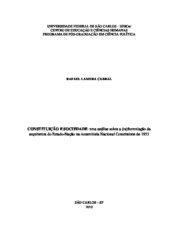| dc.contributor.author | Cabral, Rafael Lamera | |
| dc.date.accessioned | 2016-06-02T19:14:54Z | |
| dc.date.available | 2011-01-24 | |
| dc.date.available | 2016-06-02T19:14:54Z | |
| dc.date.issued | 2010-10-22 | |
| dc.identifier.citation | CABRAL, Rafael Lamera. Constituição e sociedade: uma análise sobre a (re)formulação da arquitetura do Estado-Nação na Assembleia Nacional Constituinte de 1933. 2010. 225 f. Dissertação (Mestrado em Ciências Humanas) - Universidade Federal de São Carlos, São Carlos, 2010. | por |
| dc.identifier.uri | https://repositorio.ufscar.br/handle/ufscar/982 | |
| dc.description.abstract | The objective of this research was to examine, within the platform for social change that is promoted by the Revolution of 1930 until reconstitucionalização the country with the National Constituent Assembly - NCA in 1933, the themes (i) federalism, (ii) regulation work and (iii) class representation were incorporated, through the political disputes, when it was projected to be (re) formulation in the architecture of the Brazilian Nation-State. The constitutional process performed showed the presence of the state politics (through the issues and social work) and Law (in its formatting in the legal framework Law of State) would be critical to the passage of modernity in Brazil. This constitution would be the first of the historic constitutional political and legal thinking about the modern Brazilian and both had important characteristics, because it gave voice to political and social actors in the ANC (the recruitment election result was a generalization multiplied in their representations to the model classical liberal model and the class/organic, with the participation of women, capital and labor). More than institutional innovations in engineering these changes expressed the structural transformation of Brazilian society in the period. If the new actors and interests could not be concerted in the frame of the old Constitution, it became necessary to further the political agenda and a new form of negotiation. Analyses were performed by mapping three phases of political disputes culminating in the final text of the Constitution: it was to a) draft constitution sponsored by the subcommittee of the Foreign Office (official proposal of the Provisional Government), b) discussions constituents (represented by opinion of the 26) and c) the final text of the Constitution. Across these three crops appear in the disputes highlighted the themes of federalism, the regulation of labor rights and class representation, expressions of changes in the modernization process underway in the country as resources and strategies with regard to constitutional procedure. | eng |
| dc.format | application/pdf | por |
| dc.language | por | por |
| dc.publisher | Universidade Federal de São Carlos | por |
| dc.rights | Acesso Aberto | por |
| dc.subject | Direito civil e político | por |
| dc.subject | Brasil - constituição | por |
| dc.subject | Federalismo | por |
| dc.subject | Relações trabalhistas | por |
| dc.subject | Representação social | por |
| dc.subject | Direitos sociais | por |
| dc.subject | Trabalho | por |
| dc.subject | Representação classista | por |
| dc.subject | Federalism | eng |
| dc.subject | Social rights | eng |
| dc.subject | Work | eng |
| dc.subject | Class representation | eng |
| dc.title | Constituição e sociedade: uma análise sobre a (re)formulação da arquitetura do Estado-Nação na Assembleia Nacional Constituinte de 1933 | por |
| dc.type | Dissertação | por |
| dc.contributor.advisor1 | Cepêda, Vera Alves | |
| dc.contributor.advisor1Lattes | http://lattes.cnpq.br/4917331423373631 | por |
| dc.description.resumo | O objetivo desta pesquisa era analisar, dentro da plataforma de mudança social que se promovia com a Revolução de 1930 até a reconstitucionalização do país com a Assembleia Nacional Constituinte ANC de 1933, como os temas (i) federalismo, (ii) regulamentação do trabalho e (iii) representação classista foram incorporados no momento em que se projetava a (re)formulação na arquitetura do Estado-Nação brasileiro. O processo constituinte realizado demonstrou como a política de Estado (através das questões sociais e trabalho) e o Direito (em sua formatação na estrutura legal Estado de Direito) foram fundamentais na passagem para a modernidade no Brasil. A Constituição de 1934 seria a primeira da história política constitucional e jurídica brasileira que se ajustava às novas exigências sociais do Moderno, dando voz e voto a atores políticos e sociais inéditos. Esta mudança iniciou-se já no recrutamento eleitoral ao somar à anterior experiência de representação liberal clássica (e desde o Código Eleitoral de 1932 expandindo o colégio eleitoral, inclusive na mudança substantiva do direito de voto e eleição das mulheres) com a introdução do modelo classista/orgânico que permitiu a representação direta de setores ligados ao capital e ao trabalho. Mais que inovações na engenharia institucional estas alterações expressaram a transformação estrutural da sociedade brasileira no período. Se os novos atores e interesses não conseguiam ser concertados na moldura da velha Constituição (1891), tornava-se necessário uma nova agenda política e uma nova forma de pactuação. As análises desenvolvidas nesta dissertação partem do mapeamento de três fases de disputas políticas que culminaram no texto final da Constituição: a) anteprojeto constitucional promovido pela subcomissão do Itamarati (proposta oficial do Governo provisório); b) os debates constituintes (representados pelo parecer da Comissão dos 26); e c) do texto final da Constituição. Atravessando estas três searas das disputas aparecem em destaque os temas do federalismo, da regulamentação dos direitos do trabalho e da representação classista, expressões das modificações do processo de modernização em curso no país quanto dos recursos e estratégias ao procedimento constitucional. | por |
| dc.publisher.country | BR | por |
| dc.publisher.initials | UFSCar | por |
| dc.publisher.program | Programa de Pós-Graduação em Ciência Política - PPGPol | por |
| dc.subject.cnpq | CIENCIAS HUMANAS::CIENCIA POLITICA | por |
| dc.contributor.authorlattes | http://lattes.cnpq.br/8035594335420500 | por |
